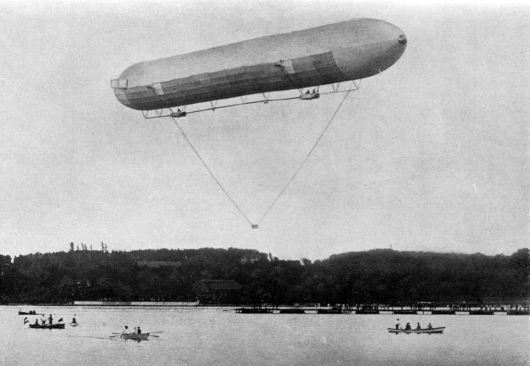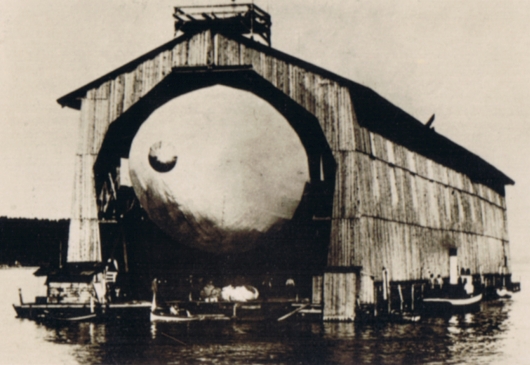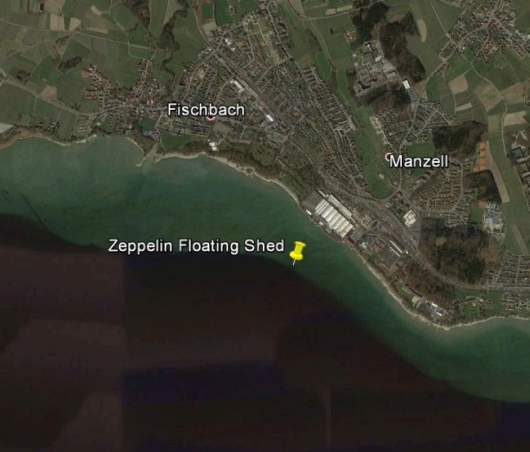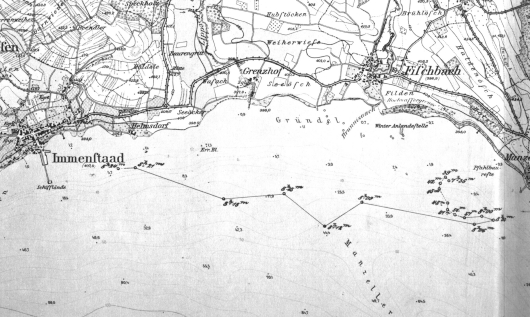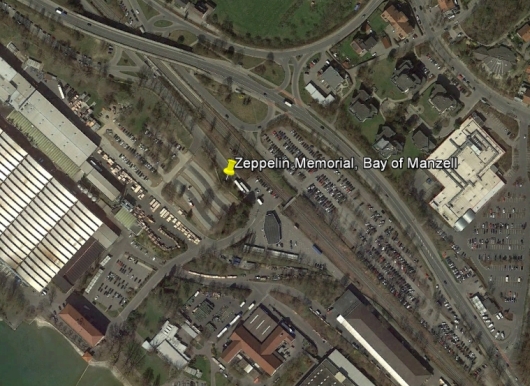LZ-1
Photo credit: Public domain, from air-ship.info.
This famous photo shows the LZ-1 on her first flight, 2 July, 1900. Little is said about this photo, but there is much to be said! The nose is at the right, so the ship is traveling from the left to the right. The ship is also attempting a hard turn to the starboard (right). This is evident because the stern rudder, starboard side, is canted fully "toward" the ship's center, thus has been deflected fully to its left for a right turn. The two forward rudders are conversely turned fully to their right, pointing directly at the camera such that only the lower rudder is resolved and just barely visible in this image, while the upper rudder was not visible by the camera as it was silhouetted against the bright sky. The suspended mass, the laufgewicht, is in the middle forming a fair equilateral triangle indicating a "level" attitude of the hull. (After this flight this mass was not suspended in this manner. Instead, the "gangway" between the control cars was rebuilt to strengthen the entire ship assembly, and the mass then slid fore and aft directly under the gangway.)
The massive "floating dock" on which the LZ-1 would be tied is visible on the water as a series of thick dashed lines, just below the horizon, below the tree-lined horizon, and the tiny silhouettes of the many handlers are visible on the dock. A few of the many thousands who turned out to witness the flight are seen in their boats.
And that's Count Zeppelin in the forward control car, along with a "Mr. von Bassus" who was flight engineer, and in the rear car is Mr. Eugen Wolf, an African explorer and machinist!
Construction
Design and construction of the LZ-1 began immediately upon the formation of the Gesellschaft zur Förderung der Luftschiffart. Controlling costs of the project, which after all, was only a “great experiment”, was important and cost, in part, led to a decision to build the “shed” to house the airship, on the lake! So the first great airship hangar was built on the shores of Lake Constance, near Manzell, Germany. This avoided land and building fees, as well as provided a place with a large and unobstructed airspace for launch and landing. Additionally, a “floating” shed meant that the shed itself could be turned into the wind to support and facilitate ingress and egress of the airship which would be vulnerable to surface winds. This latter reason is most often cited for the reason the shed was built on the lake, but really, cost and safety was a key driver. Count Zeppelin’s company was fledgling, and with no “contracts” to produce income, you can bet that every decision was heavily influenced by cost.
The LZ-1 had to be large. This Count Zeppelin understood well. It required 11,300 cubic meters of hydrogen, which, in 1899 was an unheard of volume! Count Zeppelin and his design team overcame enormous engineering difficulties in the design of the first-ever ship such as: containment of the lifting gas, handling temperature and pressure, and carrying and managing the engines. They even had to estimate in the design how such a vehicle would be flown! Remember, this had never been done, so they were entirely guessing! The result was this:
Length: 420 feet
Diameter: 38.34 feet
Volume: 399,000 cubic feet
Lift capacity: 10 tons
Engines: Two, Daimler, 4-cylinder, 14.2 hp, water cooled engines, driving 4 propellers – two forward, two aft
Speed: Estimated maximum 17 mph
Why built on the water? Von Zeppelin wanted to test his airships over water to reduce the risk to residents, crew, and the airship itself. Von Zeppelin was good friends with the King of Wurtemberg who supported him in his work. He wanted Zeppelin to have a piece of land under the Crown, so he gave Zeppelin a piece of land in Manzell, on the edge of the Bodensee. Building the great structure which would become the first rigid airship, in the relative safety and great span of the lake provided a natural solution to the problem.
Operations
“Operations” is more accurately described as “Test Flights” for the LZ-1 was 100% experimental.
First flight: As designed, the LZ-1 had control surfaces forward and aft in the form of a pair of rudders, at the bow positioned above and below the envelope, and pair of rudders at the stern, along the centerline on either side of the envelope. Initially, there was no elevator, as pitch control was intended by a heavy weight suspended 26 meters below the the middle of the airship frame, which could be slid forward or aft thus tilting the nose of the airship up or down. Forward motion would then be provided by the thrust of the propellers which could be reversed when necessary.
The first flight was well covered by the press and observed by locals with great excitement for this was the first time they had seen the ship which had been concealed in the floating shed during construction! The occasion of the first flight was the first time she had been taken out of the floating hangar! Graf Zeppelin never needed to do any “taxi” tests with the airship, as it was designed to lift off vertically, so it did not need to be removed from the hanger till she was flight ready! He had used a motor boat fitted with a propeller to test propeller design and efficiency, rather than doing such testing with the airship!
The first flight was planned for 30 June, 1900. On that date the ballast bags were filled and preparations were underway to fill the ballonets with hydrogen, but the weather turned bad and the maiden voyage was postponed. Weather also prevented the first flight the next day, 1 July, as well though the great airship was towed out of its hangar in anticipation of a launch. Weather on 2 July was also uncooperative till late in the afternoon. Finally, at 18:15, 2 July, the ship was declared ready, and at 19:30 the raft on which the ship was moored, was pulled from the shed. When the raft was clear of the shed, the mooring lines were slackened and the ship rose 30 meters above the raft. Graf Von Zeppelin gave the command to “Cast off”, and at 20:03 the airship was permitted to float freely.
Right away there was a problem, as the handlers on the raft at the stern reacted too quickly, and released the cables first, and as the ship rose to about 150 ft, a line connecting the weight became entangled with a line from one of the propeller drives! Quick action was required to level the ship. Then as the engines were run to propel the ship forward, they had great difficulty keeping the ship level, and right away the crank broke controlling the position of the “laufgewicht” (sliding weight)! Now, ballast, releasing gas, and reversing the propellers were the only means of controlling attitude.
The first flight continued with the wind, ever so slowly to the Northwest, to the delight of the crowd on the banks of the Bodensee. At 20:18 the command was given to land, and at 20:20:18 the ship landed on the water, near Immenstadt. The flight had lasted nearly 18 minutes achieving an altitude around 1300 feet, and a distance of a little over 3 1/2 miles. The motorboat “Württemberg” met the ship and placed her in tow. Unfortunately, the ship got caught in some posts sticking up from the lakebed and she was damaged. At 01:00 the next morning, she was once again safely back in the floating shed.
The damage, along with modifications required from problems observed during the first flight grounded the LZ-1 till 24 September, 1900! Along with repairs, modifications included an increase in the mass of the laufgewicht, the narrow “gangway” slung underneath the hull was built up into a deep triangular girder - stiffened by diagonal struts, as well as a change to the mechanism to contain and slide the weight - no longer suspending the mass meters below the gangway, and the rudder and elevator surfaces were significantly changed. The two rudders at the stern, on either side of the hull were moved below the hull, one in front of the other, and the bow rudder was retained on the lower portion of the hull while the upper rudder at the bow was eliminated. An elevator was added, just aft of the bow rudder.
The ship was once again ready for flight on 24 Sep, 1900, but on 25 Sep, a suspension cable broke, permitting the center part of the hull to crash to the raft, causing serious damage to the ship’s frame. Repairs took to the 14th of October.
Weather prevented operations till the 17th of October. At 16:45 that day, she made her second flight. Despite difficulties with control, she stayed airborne for 1 hour, 20 min, traveling 6.8 mi to near Meersburg and back to Manzell. The landing was cut short due to a rapid dip of the nose during landing operations whereupon the nose struck the water. Damage was slight, and the ship settled on the water. On October 21st, she had her 3rd and final flight which began at 17:02. She made 3 successful accents and descents, and demonstrated much more positive control. At 17:25 the airship was landed, and by 18:00 was successfully towed back to the hangar and stored.
Demise
Much was learned by von Zeppelin and his engineers on the 3 brief flights of the LZ-1, and many improvements were planned. Unfortunately, no one showed interest in the grand experiment, including the German army which did not foresee the value in an airship. Strapped for cash, von Zeppelin was forced to hangar the LZ-1 in search of funds. Sometime in January, 1901, violent storms passed through the area. A news entry in the July 27, 1901 issue of Scientific American reported the storms "demolished the balloon house and ripped open the aerostat for about a third of its length. The inner framing, which was constructed of aluminium, was also badly twisted, and a large part of it was torn away."
Now it does not seem entirely accurate that the floating shed was "demolished" in the storm, as an undated, but later photo, seen here, shows the original shed "docked" at the bank of Lake Constance and the new, 2nd shed floating in the water.
Photo credit: air-ship.info, public domain.
Ignominious End
Zeppelin found the interest in his prototype machine so low that, his capital exhausted, he had to disband his company. The LZ-1 was scrapped and sometime later in 1901, dismantled. The floating hangar sat empty in an unknown state. Work was stopped. But Zeppelin, undaunted, went to work seeking funds. It would take 5 years.
Sites of Interest
Manzell, Germany, Lake Constance (Bodensee):
Here is the most intriguing photo of the LZ-1! Widely found on the Web, this is a photo of the LZ-1 in the shed which was built for it. The exact date of the photo is not known, but she was only withdrawn twice from the shed in the configuration visible seen here (aft rudders mounted on either side of the hull) first on 1 July, and then on 2 July, 1900. In this shot, she is likely being extracted from her shed! How can I say this? The exposed stern of the ship suggests she was being withdrawn! The LZ-1 itself was 420 feet long, the shed is said to be "500 ft long", measures from photographs to be about 445 feet, and probably most accurate, the May 26, 1900 issue of Scientific American says the shed was 472 feet long! If the ship was fully in the hangar, the stern would be fully within the plane of the shed's opening.
Photo credit: Public domain.
It's easy to identify the fact that the Zeppelin airship work was done on Lake Constance, near Freidrichshaffen, actually near Manzell. It was considerably harder to find the exact location! It was a wonderful trek of discovery, because there are many Zeppelin monuments in the area, but it took some time to sleuth out exactly where the Zeppelin floating shed had once been on Lake Constance.
It's easy to identify the fact that the Zeppelin airship work was done on Lake Constance, near Friedrichshafen, actually near Manzell. It was considerably harder to find the exact location! It was a wonderful trek of discovery, because there are many Zeppelin monuments in the area, but it took some time to sleuth out exactly where the Zeppelin floating shed had once been on Lake Constance.
The location I estimate was here:
Photo credit: Google Earth.
The map-tack is at (Lat Lon) 47.660281 009.422714, but of course, the Shed could have been anchored anywhere within a few hundred yards of this point. (Click here to View in Google Maps). Obviously this "exact location" has little meaning as the shed could be anchored anywhere they wanted.
I found a very nice map showing the approximate flight path of the first flight of the LZ-1, and curiously, on the map is the annotation, in German: "Winter Anlandestelle" ("Winter Landing Site"), with a small dashed shape which looks very much like the outline of the shed! This map, when overlaid onto Google Earth fits very well, and includes the time-hacked locations of the LZ-1 on its brief, history making flight:
Photo credit: http://www.cds.fn.bw.schule.de/zeppelin-projekt/.
Manzell, Germany, Zeppelin Monument:
If you look back the Google Earth image above of the location of the Zeppelin Floating Shed, on the shore, toward Manzell you see a large group of buildings with white roofs. This was the location of the Zeppelin workshops from 1898 to about 1908. On the northeast side of these buildings is a wonderful marker, a small monument to recognize this location as the site of the first Zeppelin facotry:
Photo credit: Christian Benzinger, http://www.luftschiffharry.de.
The plaque reads: "On this shore Graf Ferdinand von Zeppelin built his first dirigible airship in the year 1900". The precise position of the monument is here:
Photo credit: Google Earth.
The map-tack is at (Lat Lon) 47.663182 009.430147, the exact spot of the stone. (Click here to View in Google Maps).

